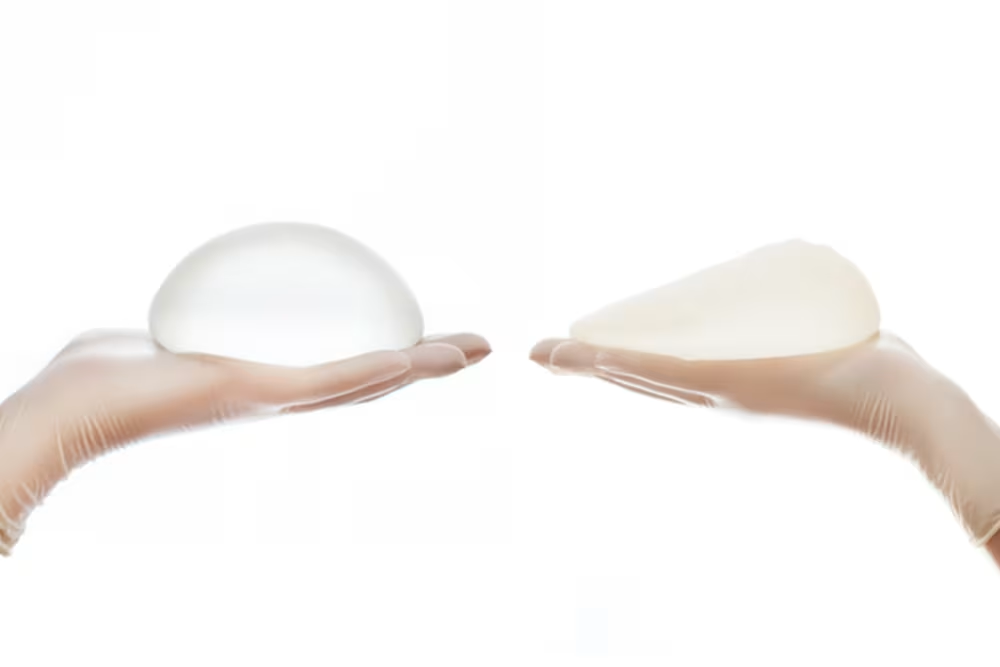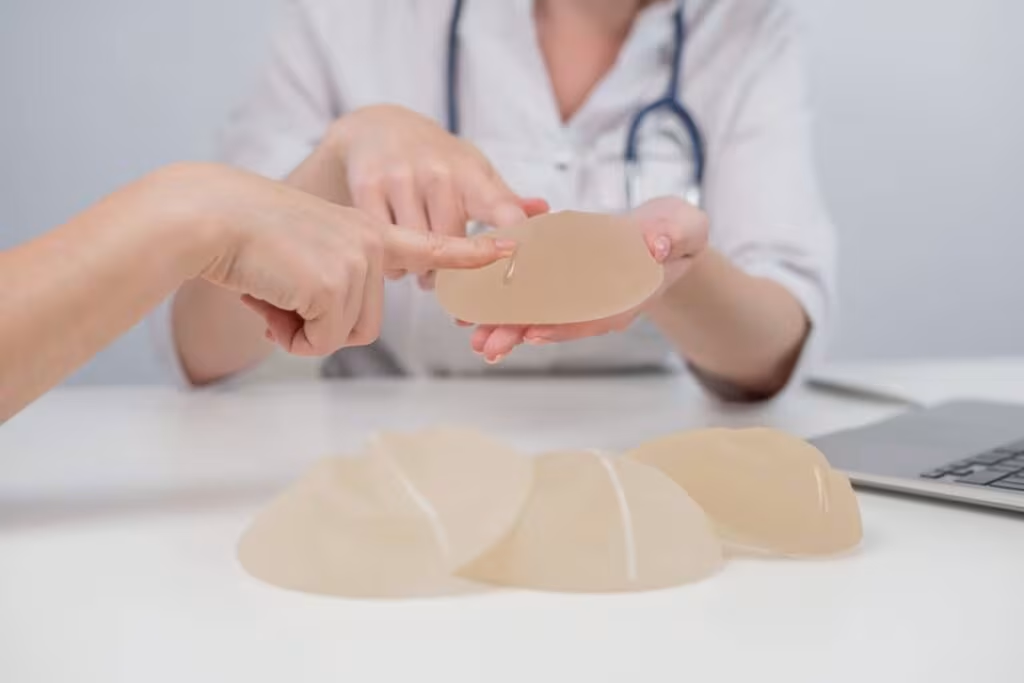Breast implant exchange is a surgical procedure that involves replacing existing breast implants with new ones. The reasons for considering this procedure can range from aesthetic desires to medical issues with the current implants.
This article aims to provide an overview of the breast implant exchange pros and cons, helping you make an informed decision about this procedure.

Understanding Breast Implant Exchange
Breast implant exchange surgery involves swapping current implants for new ones, enhancing or altering the appearance as desired.
This operation can be done for a variety of reasons, including dissatisfaction with the current implant size, shape, feel, or position, aging or deflation of old saline/silicone implants, development of capsular contracture or asymmetry, or a desire to switch from saline to silicone implants.
New advances in breast augmentation options may also prompt some individuals to consider this procedure.
Benefits of Breast Implant Exchange
A breast implant exchange surgery brings about numerous potential benefits. Primarily, it is a solution to implant-related complications like capsular contracture and asymmetry.
Capsular contracture is a condition where the scar tissue surrounding the breast implants tightens, causing discomfort and altering the breast shape. Asymmetry, on the other hand, affects the balance and proportionality of the breasts.
These issues not only cause breast pain but also impact the breast appearance, potentially leading to a loss of confidence. The breast implant exchange procedure can effectively rectify these problems, providing relief from discomfort and restoring a natural, fuller breast appearance.
This surgical procedure also allows for the replacement of aging or ruptured implants, therefore restoring the desired look and feel that might have been compromised over a period of time.
Addressing Implant-Related Issues and Complications
Breast implants can develop complications over time, such as capsular contracture. This can cause discomfort and lead to notable changes in breast shape and size, affecting the aesthetic goals initially achieved by the original breast augmentation surgery. Another concern can be the loss of breast volume or deflated implants, which can happen due to weight loss or simply aging.
This procedure, performed by a board-certified plastic surgeon, can rectify these implant-related complications, ensuring a successful aesthetic outcome and improved body image.
Improving Self-Confidence and Body Image
In addition to physical benefits, implant exchange can also have psychological benefits. For many individuals, having the desired breast shape and size can significantly improve self-confidence and body image.
Opportunity to Upgrade or Change Implant Size or Type
One of the primary benefits of implant exchange is the opportunity to upgrade or change the size or type of your implants, which is one of the common reasons for considering breast implant replacement. Over time, you may find that your aesthetic goals have changed, or you may simply wish to take advantage of the latest advances in implant technology.
For example, you may want to switch from saline to silicone breast implants, which are considered to have a more natural feel. Alternatively, you might wish to change the size of your implants to better suit your current body frame or lifestyle.
Risks of Breast Implant Exchange
Just like any medical intervention, the breast implant exchange procedure comes with inherent surgical risks that should be considered and discussed with your healthcare provider.
General Anesthesia Considerations
Undergoing general anesthesia carries certain risks, including potential allergic reactions and respiratory difficulties during or after the procedure. It’s crucial to understand how anesthesia may affect your body. Therefore, it’s advisable to have a thorough discussion with your surgeon and anesthesiologist about these possible risks before your cosmetic surgery.
Infection Prevention and Management
The risk of infection is inherent in any surgical procedure, including breast implant exchange surgery. Adhering to strict hygiene practices and proper aftercare is crucial in mitigating the risk of infection post-surgery.
Detailed instructions on how to care for your incision sites will be provided by your experienced plastic surgeon to minimize the risk of infection. In the event of an infection, it is imperative to immediately contact your surgeon for treatment and management.
Capsular Contracture as a Persistent Risk
Capsular contracture remains a persistent risk of complications even after a breast implant exchange. While measures are taken during the surgical procedure to minimize this risk, it’s crucial to understand that this complication can still occur.
Regular follow-up consultation appointments with your surgeon can help monitor for signs of capsular contracture.
Additional Risks Specific to Implant Exchange
There are specific risks associated with breast implant exchange surgery that you should be aware of. These include alterations in breast shape and breast sensation. For instance, you may experience a loss of nipple sensation or changes in the overall feel of your breast.
In addition, there is a risk of breast implant ruptures, which can have different implications depending on the type of breast implant – saline or silicone. Being aware of these risks can assist you in making an informed decision about the procedure.
Factors to Consider Before Undergoing Breast Implant Exchange
Before deciding to undergo breast implant exchange, several factors should be considered.
Importance of Implant Selection
Choosing the right type of breast implant is crucial to achieving your desired aesthetic outcome. There are several types of implants, including saline and silicone, each with its own pros and cons.
For instance, silicone implants are often considered to have a more natural feel but pose a higher risk if they leak or rupture. Your surgeon can provide you with detailed information about the different types of implants and help you make an informed decision.
Realistic Expectations and Potential Limitations
While breast implant exchange can greatly improve your appearance and self-confidence, it’s important to have realistic expectations about the results. The procedure can’t necessarily give you the perfect body, but it can enhance your natural features and improve your overall body image.
Keep in mind there may be limitations based on your medical history and current health status. Your surgeon can help you understand what results are achievable, given your individual circumstances.
Evaluating the Need for Other Complementary Procedures
In some cases, additional surgeries may be necessary to achieve your desired results. For instance, if you have significant sagging or loss of volume, a breast lift may be recommended in conjunction with the implant exchange.
Your surgeon can evaluate your needs during your consultation and recommend the most appropriate course of action to meet your cosmetic goals.

Consulting with a Qualified Plastic Surgeon
The success of your breast implant exchange largely depends on the expertise of the surgeon performing the cosmetic procedure. It’s important to choose a qualified and experienced plastic surgeon, like Dr. Paul Vitenas, who has a proven track record in performing breast implant exchange procedures.
During your consultation, ask about their experience, their approach to the procedure, and what you can expect during recovery. To schedule your consultation with Dr. Vitenas, please contact us at 281-484-0088.
